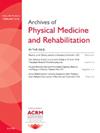Attention Allocation Impacts Postural Control in Patients with Diabetes
IF 3.6
2区 医学
Q1 REHABILITATION
Archives of physical medicine and rehabilitation
Pub Date : 2025-04-01
DOI:10.1016/j.apmr.2025.01.065
引用次数: 0
Abstract
Objectives
To identify how attention allocation impact postural control between patients with diabetes mellitus (DM) and age-matched healthy adults when engaging in an attention-demand task.
Design
Cross-sectional and observational study.
Setting
Hospital and Research Institute Setting.
Participants
Data from 10 patients with DM (age, 59±10y; 4 females) and 10 healthy age-matched adults (age, 62±12y; 7 females) were analyzed. Key inclusion criteria of patients with DM included: (1) age ranged from 19 to 79 years; (2) can stand independently; (3) no other neuromuscular conditions that impact the balance.
Interventions
Participants were well-secured with a harness system and instructed to stand still with eyes open: (1) on a force plate, and (2) on a foam pad that mimicked the unstable surface. To reallocate participants attention, an auditory Stroop test (AST) that consisted of high and low pitch sound was administered concurrently during the trials. Participants were instructed to answer the correct pitch of the sound instead of the heard words.
Main Outcome Measures
Participants’ postural sway (regarding the center of press and its rambling and trembling) was quantified using the linear (root mean square) and nonlinear analyses (Sample Entropy). The pupil dilation was converted into the Index of Cognitive Activity (ICA). Lastly, the AST correctness was documented (%).
Results
When compared with age-matched healthy adults, DM showed increased center of pressure movement in the anteroposterior direction. When compared with task difficulty within group, DM presented decreased rambling and trembling Sample Entropy in both anteroposterior and mediolateral directions when standing on a unstable surface. Similarly, both DMs ICA and correctness decreased when standing on a unstable surface.
Conclusions
This study demonstrated that DM reallocated the attention to postural control while engaging in an attention-demand task by presenting the decreased ICA and AST correctness. Although DMs attention reallocation represented the strategy adopted to maintain balance in a challenging condition, it is notably that the decreased rambling and trembling Sample Entropy may imply a high predictability and regularity of postural control that differs from the age-matched healthy adults.
Disclosures
none.
求助全文
约1分钟内获得全文
求助全文
来源期刊
CiteScore
6.20
自引率
4.70%
发文量
495
审稿时长
38 days
期刊介绍:
The Archives of Physical Medicine and Rehabilitation publishes original, peer-reviewed research and clinical reports on important trends and developments in physical medicine and rehabilitation and related fields. This international journal brings researchers and clinicians authoritative information on the therapeutic utilization of physical, behavioral and pharmaceutical agents in providing comprehensive care for individuals with chronic illness and disabilities.
Archives began publication in 1920, publishes monthly, and is the official journal of the American Congress of Rehabilitation Medicine. Its papers are cited more often than any other rehabilitation journal.

 求助内容:
求助内容: 应助结果提醒方式:
应助结果提醒方式:


